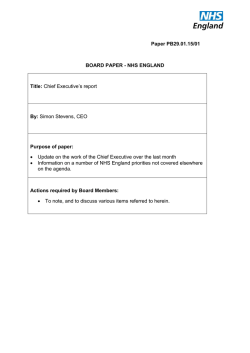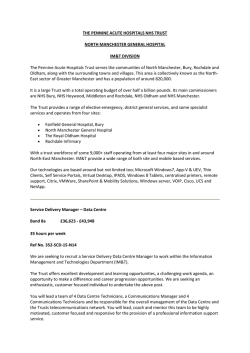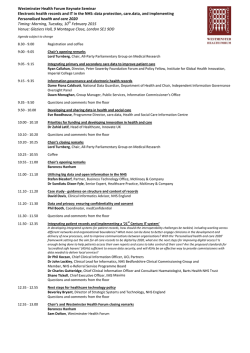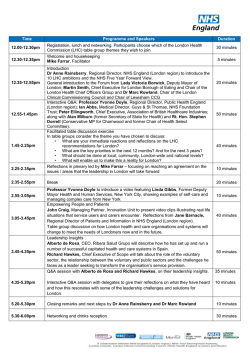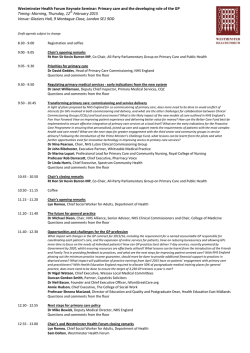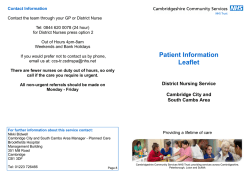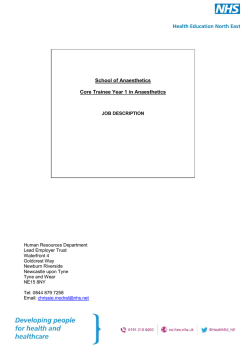
Accident and Emergency Attendances in England - 2013
Hospital Episode Statistics Accident and Emergency Attendances in England - 2013-14 Published 28 January 2015 Hospital Episode Statistics: Accident and Emergency Attendances in England 2013-14 We are the trusted national provider of high-quality information, data and IT systems for health and social care. www.hscic.gov.uk [email protected] @hscic This document has been written primarily for those working in the NHS, to inform and support strategic and policy led processes for the benefit of patient care. This document will also be of interest to researchers, journalists and members of the public interested in NHS hospital activity in England. Author: Hospital Episode Statistics Analysis, Health and Social Care Information Centre Responsible statistician: Jane Winter, Section Head Version: V1.0 Date of publication: 28 January 2015 Copyright © 2015, Health and Social Care Information Centre. All rights reserved. 2 Hospital Episode Statistics: Accident and Emergency Attendances in England 2013-14 Contents Executive Summary 4 Introduction 4 Key Facts 5 Background 6 A&E departments 6 Reporting of A&E data 6 Weekly A&E situation reports (Sit Reps) 6 Assessing growth through time 6 Findings 8 Overview 8 Accessing HES 9 Feedback 9 Appendices 10 Appendix 1: Data submissions 10 Appendix 2: Glossary of terms 11 Appendix 3: Hospital Episode Statistics Data Quality Statement 12 Copyright © 2015, Health and Social Care Information Centre. All rights reserved. 3 Hospital Episode Statistics: Accident and Emergency Attendances in England 2013-14 Executive Summary Introduction Hospital Episode Statistics (HES) come from the HES data warehouse containing details of all admissions, outpatient appointments and accident and emergency (A&E) attendances at NHS hospitals in England. It includes private patients treated in NHS hospitals, patients who were resident outside of England and care delivered by treatment centres (including those in the independent sector) funded by the NHS. HES datasets are the data source for a wide range of healthcare analysis for the NHS, Government and many other organisations and individuals. Records in the HES A&E database are called ‘attendances’, and each A&E attendance relates to a single visit by an individual to A&E. Where follow up care is required and provided by the A&E department a second planned attendance is recorded. Each record in HES includes a wide range of information including details of the patient (age, sex, geographic details), when they were treated and what they were treated for. This publication releases some high level analyses of HES data relating to A&E attendances in NHS hospitals. Copyright © 2015, Health and Social Care Information Centre. All rights reserved. 4 Hospital Episode Statistics: Accident and Emergency Attendances in England 2013-14 Key Facts1 In 2013-14: 1 There were 18.5 million accident and emergency attendances recorded at major A&E departments, single specialty A&E departments, walk-in centres and minor injury units in England; an increase of 1.0 per cent from 2012-13. Data is incomplete; there are 18.2 million attendances reported in A&E HES (excluding planned follow-up attendances), compared to 21.8 million reported in NHS England’s Weekly A&E situation reports (Sit Reps) aggregate data for the equivalent period. There are 205 providers with attendances recorded in A&E HES compared to 247 providers who have submitted A&E attendances via Weekly A&E Sit Reps. Weekly A&E Sit Reps receives data from a number of private providers, walk in centres and minor injury units that do not currently submit data to HES. Figures in this report have been rounded. Percentage calculations are based on the un-rounded figures. Copyright © 2015, Health and Social Care Information Centre. All rights reserved. 5 Hospital Episode Statistics: Accident and Emergency Attendances in England 2013-14 Background A&E departments The role of major accident and emergency (A&E) departments is to assess and treat patients who have serious and unforeseen injuries or illnesses. Major A&E departments are consultant-led, open 24 hours a day and 365 days a year with full resuscitation facilities. Not all hospitals have an A&E department. In addition to major A&E departments, single specialty A&E departments, walk-in centres and minor injury units are also covered by the HES A&E data. People can attend these services without an appointment. They deal with a range of minor injuries and illnesses. Reporting of A&E data HES A&E data consists of individual records of patient care that are held within the HES database. These have been submitted from local NHS providers’ Patient Administration Systems (PAS) via the Secondary Uses Service (SUS), a national data warehouse. Weekly A&E situation reports (Sit Reps) The collection process used for HES A&E data is very different from the process used for collecting date for the other nationally published source of information on A&E activity, the weekly A&E situation reports (Sit Reps). Weekly Sit Reps are based on counts made in local NHS organisations and submitted to the NHS England in aggregate form, rather than from patient level data. This aggregate data is still the official source of A&E information and should be used in preference to HES A&E data for information that is held in both data sets. Weekly Sit Reps data are available here – http://www.england.nhs.uk/statistics/statisticalwork-areas/ae-waiting-times-and-activity/ Assessing growth through time A&E HES figures are available from 2007-08 onwards. Changes to the figures over time need to be interpreted in the context of both improvements in data quality and coverage and changes in activity. The introduction of Payment by Results (PbR), increased private sector involvement in the delivery of secondary care and some changes in clinical practice (including some procedures occurring as outpatient appointments instead of hospital admissions) will have all affected trends. PbR is a system whereby hospitals are paid for the number of patient treatments, known as activity, they perform and the complexity of these treatments. It was introduced in a phased way from 2003-04 onwards. In order to get paid correctly, hospitals need to record the activity they perform and the clinical codes that outline the patients’ conditions and treatment. This has provided a major financial incentive for hospitals to ensure all of the activity they perform and the clinical coding is fully recorded. This improved recording of information captured by HES could be one of the factors leading to the reported activity increases. One of the key government priorities since the introduction of PbR has been for patients to wait for as short a time as possible. In order to decrease patients’ waiting times there has been the need for additional elective operations to be performed and more capacity in NHS funded care to perform this activity. In the middle of the last decade, additional capacity was Copyright © 2015, Health and Social Care Information Centre. All rights reserved. 6 Hospital Episode Statistics: Accident and Emergency Attendances in England 2013-14 brought in from the private sector via Treatment Centres, with the NHS funding some patients to be treated there for routine operations. Improvements in technology and the need to increase efficiency to allow more patients to be treated have led to a reduction in the length of time patients need to stay in hospital for certain planned operations. In particular, many of those operations that would have involved an overnight stay at the start of the period are now routinely performed as day cases. In addition, many operations where a patient would have been admitted to hospital at the start of the period are now routinely performed in outpatients. This has led to increases in day case rates and outpatient attendances over the period. The NHS has seen increases in real terms expenditure throughout the period. In the earlier years of the period, the year-on-year increase in this expenditure was higher than in the most recent years. The period has also seen a rise in the number of emergency admissions. One factor contributing to this is likely to be the increased demand on health services from an ageing population. Alongside this there has been the introduction of observation or medical assessment units at many hospitals to which patients arriving in Accident and Emergency departments are admitted, often for around a day, to enable observation and tests to be performed on them. The data we have provided here highlight these changes. Care should be taken when interpreting these changes as improvements in coverage in HES will contribute alongside growth from increased activity. Extra care should be taken when looking at clinical data, as changes in NHS practices (such as the introduction of new procedures and interventions) can have an effect on changes through time. Copyright © 2015, Health and Social Care Information Centre. All rights reserved. 7 Hospital Episode Statistics: Accident and Emergency Attendances in England 2013-14 Findings Overview In 2013-14 there were 18.5 million A&E attendances recorded at major A&E departments, single specialty A&E departments, walk-in centres and minor injury units in England; an increase of 1.0 per cent from 2012-13. This difference is largely driven by coverage improvements within A&E HES. Over the same period A&E attendance levels reported within A&E Sit Reps increased by 0.2per cent. Table 1a: Headline figures Number Total 18,517,381 Proportion of planned attendances Per cent 100.0 1.7 Proportion admitted to hospital 20.9 Source: Health and Social Care Information Centre Table 1b: Comparison to SitReps Number HES unplanned attendances 18,197,530 A&E SitReps attendances 21,778,657 HES number of providers 205 A&E SitReps number of providers 247 Source: Health and Social Care Information Centre Copyright © 2015, Health and Social Care Information Centre. All rights reserved. 8 Hospital Episode Statistics: Accident and Emergency Attendances in England 2013-14 Accessing HES The HES publications focus on headline information about hospital activity. The Health and Social Care Information Centre publish data dictionaries for HES describing the format and possible values for all HES data items: http://www.hscic.gov.uk/hes The data is also readily accessible via an online interrogation service (for NHS users) or via our bespoke extract service: http://www.hscic.gov.uk/hdis http://www.hscic.gov.uk/dars Feedback Feedback on this publication can be provided via our website: http://www.hscic.gov.uk/haveyoursay Alternatively, feedback can be provided to the Health and Social Care Information Centre via [email protected] or 0300 303 5678. The Health and Social Care Information Centre welcomes all feedback relating to any aspect of this publication. In particular we would welcome feedback on the usefulness of the information to different users, the ways in which the information is used and what further information would be useful. Any additional information you can provide us with about your use of HES data will help us to improve our statement on known users and uses of the data available at: http://www.hscic.gov.uk/media/10495/Users-and-uses-ofHES/pdf/HES_Users_and_Uses.pdf Copyright © 2015, Health and Social Care Information Centre. All rights reserved. 9 Hospital Episode Statistics: Accident and Emergency Attendances in England 2013-14 Appendices Appendix 1: Data submissions A list of mandatory and optional fields for submission in the Accident and Emergency Commissioning Data Set (CDS) is provided within the CDS data dictionary http://www.datadictionary.nhs.uk/web_site_content/cds_supporting_information/commissioning_ data_set_version_6-2_type_list.asp?shownav=0 CDS V6-2 Type 010 - Accident and Emergency CDS Please note: The markers in the columns "OPT, U/A, and HES" indicate the NHS recommendations for the inclusion of data: M = Mandatory: data must be included where available O = Optional: data need not be included * = Must not be used Copyright © 2015, Health and Social Care Information Centre. All rights reserved. 10 Hospital Episode Statistics: Accident and Emergency Attendances in England 2013-14 Appendix 2: Glossary of terms A&E Accident and Emergency AR Annual Refresh CCG Clinical Commissioning Group CDS Commissioning Data Set DH Department of Health HES Hospital Episode Statistics HSCIC Health and Social Care Information Centre MIU Minor Injury Unit NHS National Health Service ONS Office for National Statistics OOH Out of Hours OP Outpatient PAS Patient Administration Systems PCT Primary Care Trust SHA Strategic Health Authority SUS Secondary Uses Service WIC Walk-in Centre Copyright © 2015, Health and Social Care Information Centre. All rights reserved. 11 Hospital Episode Statistics: Accident and Emergency Attendances in England 2013-14 Appendix 3: Hospital Episode Statistics Data Quality Statement Introduction HES data includes patient level data on hospital admissions, outpatient appointments and A&E attendances for all NHS trusts in England. It covers acute hospitals, mental health trusts and other providers of hospital care. HES includes information about private patients treated in NHS hospitals, patients who were resident outside England and care delivered by treatment centres (including those in the independent sector) funded by the NHS. Healthcare providers collect administrative and clinical information locally to support the care of the patient. This data is submitted to the Secondary Uses Service (SUS) to enable hospitals to be paid for the care they deliver. HES is created from SUS to enable further secondary use of this data. HES is the data source for a wide range of healthcare analysis used by a variety of people including the NHS, government, regulators, academic researchers, the media and members of the public. HES is a unique data source, whose strength lies in the richness of detail at patient level going back to 1989 for inpatient episodes, 2003 for outpatient appointments and 2007 for A&E attendances. HES data includes: specific information about the patient, such as age, gender and ethnicity; clinical information about diagnoses, operations and consultant specialties; administrative information, such as time waited, and dates and methods of admission and discharge; and geographical information such as where the patient was treated and the area in which they live. The principal benefits of HES are in its use to: monitor trends and patterns in NHS hospital activity; Assess effective delivery of care and provide the basis for national indicators of clinical quality; support NHS and parliamentary accountability; inform patient choice; provide information on hospital care within the NHS for the media; determine fair access to health care; develop, monitor and evaluate government policy; reveal health trends over time; and support local service planning. Relevance The HES publications focus on headline information about hospital activity. Each annual publication includes a series of national tables and also provider level breakdowns for some main areas. Copyright © 2015, Health and Social Care Information Centre. All rights reserved. 12 Hospital Episode Statistics: Accident and Emergency Attendances in England 2013-14 Most data included in the published tables are aggregate counts of hospital activity. Where averages are published, e.g. average length of stay for inpatients or caesarean rates for maternity statistics, the data is clearly labelled stating how the data has been calculated. Accessibility As HES is such a rich source of data it is not possible to publish aggregate tables covering all permutations of possible analysis. Underlying HES data is also made available to facilitate further analysis that is of direct relevance to users. Accuracy and Reliability The accuracy of HES data is the responsibility of the NHS providers who submit the data to SUS. This data is required to be accurate to enable them to be correctly paid for the activity they undertake. HSCIC has a well-developed data quality assurance process for the SUS and HES data. It uses an xml schema to ensure some standardisation of the data received. The use of the schema means that the dataset has to meet certain validation rules before it can be submitted to SUS. HSCIC leads on the schema changes and consults the data suppliers about proposed changes. Each month the HSCIC makes data quality dashboards available to NHS providers to show the completeness and validity of their data submissions to SUS. This helps to highlight any issues present in the provisional data allowing time for corrections to be made before the annual data is submitted. An external auditor, acting on behalf of the Department for Health, audits the data submitted to SUS to ensure NHS providers are being correctly paid by PbR for the care they provide. HSCIC validates and cleans the HES extract and derives new items. The team discusses data quality issues with the information leads in hospital trusts who are responsible for submitting data. The roles and responsibilities within HSCIC are clear for the purposes of data quality assurance, i.e. to assess the quality of data received against published standards and report the results. Data quality information for each year to date HES dataset is published alongside the provisional year to date HES data, and also alongside annual publications. These specify known data quality issues each year, e.g. if a trust has a known shortfall of secondary diagnoses. The statisticians can only check the validity and format of the data and not whether it is accurate, as accuracy checking requires a level of audit capacity and capability which the HSCIC does not currently possess. There is also further information about HES data quality published online: http://www.hscic.gov.uk/article/1825/The-processing-cycle-and-HES-data-quality HSCIC also publishes an annual report The Quality of Nationally Submitted Health and Social Care Data which highlights issues around the recording of the underlying data that are used for HES, as well as examples of good and poor practice The UK Statistics Authority conducted case studies of quality assurance and audit arrangements of administrative data sources. HES was used as a case study and further information can be found in the published report: http://www.statisticsauthority.gov.uk/assessment/monitoring/administrative-data-and-officialstatistics/quality-assurance-and-audit-arrangements-for-administrative-data.html Copyright © 2015, Health and Social Care Information Centre. All rights reserved. 13 Hospital Episode Statistics: Accident and Emergency Attendances in England 2013-14 Data Completeness As explained above, there are some definitional differences between A&E HES data and Weekly A&E Sit Reps data. The main difference is that A&E Sit Reps data does not include attendances where the A&E appointment has been pre-arranged or planned. Therefore, where A&E HES is compared directly with A&E Sit Reps planned follow-up attendances are excluded. Overall coverage in HES has increased slightly from 2012-13 compared to the A&E Sit Rep data, although data completeness of key fields remains at similar levels to the previous year. Codes were considered to be valid if they matched to one of the A&E Commissioning Data Set (CDS) data dictionary values for the specified field and were considered invalid if they did not match one of the data dictionary values. Where a field has a null value it is considered invalid. Multiple diagnosis, investigation and treatment codes can be submitted within the data set. The analysis contained within this report only looks at the first (or primary) diagnosis, investigation and treatment codes submitted. It also only uses the first two characters of these codes covering the diagnosis condition, investigation and treatment sections of the six character codes. This is due to quality issues with these clinical fields. Final and Provisional Data Comparison Collection of HES data is carried out on a monthly basis throughout the financial year, with a final annual refresh (AR) once the year end has passed. Each monthly collection refreshes data back to the start of the financial year. ‘Month 13’ represents the provisional full year data and was published in June 2014. Hospital providers and the HSCIC HES Data Quality team work to improve the quality and completeness of the data in order to produce the final annual refresh data used in this report, as described in ‘Accuracy and Reliability’. Timeliness and Punctuality HES data is published as early as possible. The production of the underlying HES datasets takes several months after the reference period. The final submission deadline for NHS providers to send annual data to SUS is normally at the end of the May, almost 2 months after that year has finished. It then takes approximately 3 months to produce the APC HES dataset and a further 2 months to complete publication production and data investigation. However, annual HES publications relating to final 2013-14 data are following a slighter later publication schedule - the reason for this is that the processing of annual HES data has been transferred in-house to HSCIC from the previous third-party supplier, and therefore additional time is needed this year to test and assure the new arrangements. In addition to annual data the HSCIC also publish provisional monthly HES data approximately 3 months after the reference period. The final annual data includes additional data cleaning, validation and processing than the provisional monthly data. Copyright © 2015, Health and Social Care Information Centre. All rights reserved. 14 Hospital Episode Statistics: Accident and Emergency Attendances in England 2013-14 Coherence and Comparability Users can misinterpret HES data as relating to numbers of patients but care should be taken as HES data relates to hospital activity, not individuals. A&E data is presented as attendances which may include people attending more than once in the reporting period. UK comparisons Separate collections of hospital statistics are undertaken by Northern Ireland, Scotland and Wales. There are a number of important differences between the countries in the way that data measures are collected and classified, and because of differences between countries in the organisation of health and social services. For these reasons, any comparisons made between HES and other UK data should be treated with caution. ONS used to produce UK Health Statistics which contained key figures about the use of health and social services, including hospital admitted patient activity and waiting times across the UK. The last version of this discontinued series can be found at: http://www.ons.gov.uk/ons/rel/ukhs/united-kingdom-health-statistics/2010/edition-4--2010.pdf Other UK Data: Hospital data for the other administrations can be found at: Northern Ireland – Hospital Statistics Scotland – Hospital Care Wales – Health and social care statistics NHS England also publish hospital activity data: http://www.england.nhs.uk/statistics/statistical-work-areas Wider international comparisons HES and similar statistics from the devolved administrations are used to contribute to World Health Organisation (WHO), Organisation for Economic Co-operation and Development (OECD) and Eurostat compendiums on health statistics. Improvements over time HES data are available from 1989-90 onwards. Changes to the figures over time need to be interpreted in the context of improvements in data quality and coverage (particularly in earlier years), improvements in coverage of independent sector activity (particularly from 2006-07) and changes in NHS practice. For example, apparently reductions in activity may be due to a number of procedures which may now be undertaken in outpatient settings and so are no longer included in APC HES data. Changes to clinical classifications Diagnoses are coded in HES using the ICD10 classification. Operative procedures are coded in HES using the OPCS classification. Further information about these classifications, and changes to them, can be found at: http://systems.hscic.gov.uk/data/clinicalcoding Copyright © 2015, Health and Social Care Information Centre. All rights reserved. 15 Hospital Episode Statistics: Accident and Emergency Attendances in England 2013-14 Changes to organisation codes and geographical boundaries The Organisation Data Service (ODS) is responsible for the publication of all organisation and practitioner codes and national policy and standards with regard to the majority of organisation codes, and encompasses the functionality and services previously provided by the National Administrative Codes Service (NACS). For more information about the ODS and changes to organisation codes and geographical boundaries visit: http://systems.hscic.gov.uk/data/ods Performance, Cost and Respondent Burden The production of HES data is a secondary use of data collected during the care of patients in the NHS and submitted for NHS Providers to be paid for the care they deliver. Therefore HES does not incur additional costs or burden on the providers of the data. Confidentiality, Transparency and Security Although certain information is considered especially sensitive, all information about someone's health and the care they are given must be treated with regard to confidentiality at all times. There are a limited number of people authorised to have access to the record level data, all of who must adhere to the written protocol issued by The HSCIC on the dissemination of HES data. For example, guidance is given on handling the very small numbers that sometimes occur in tables to reduce the risk that local knowledge could enable the identification of either a patient or clinician. HES is a record level data warehouse and it contains information that could (if it was made freely available) potentially identify patients or the consultant teams treating them. In some cases record level data may be provided for medical/health care research purposes. For example, data is likely to be required by the Care Quality Commission and other such bodies. The information may be given following a stringent application procedure, where the project can justify the need and where aggregated data will not suffice. Any request involving sensitive information, or where there may be potential for identification of an individual, is referred to the appropriate governance committee. HSCIC publishes a quarterly register of data releases, which includes releases of HES data. HES data is stored to strict standards: a system level security protocol is in place. This details the security standards that are in place to ensure data is secure and only accessed by authorised users Copyright © 2015, Health and Social Care Information Centre. All rights reserved. 16 Hospital Episode Statistics: Accident and Emergency Attendances in England 2013-14 Published by the Health and Social Care Information Centre Part of the Government Statistical Service Responsible Statistician Jane Winter, Section Head ISBN 978-1-78386-309-9 This publication may be requested in large print or other formats. For further information www.hscic.gov.uk 0300 303 5678 [email protected] Copyright © 2015 Health and Social Care Information Centre. All rights reserved. This work remains the sole and exclusive property of the Health and Social Care Information Centre and may only be reproduced where there is explicit reference to the ownership of the Health and Social Care Information Centre. This work may be re-used by NHS and government organisations without permission. Copyright © 2015, Health and Social Care Information Centre. All rights reserved. 17
© Copyright 2024
